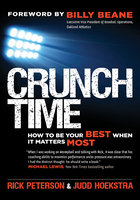
INTRODUCTION Rick and Izzy
Baseball is 90 percent mental. The other half is physical.
—YOGI BERRA
It’s October 11, 2001, and the Oakland A’s are playing the New York Yankees in Game 2 of the opening round of the American League Playoffs. Nearly 57,000 raucous fans are in attendance at Yankee Stadium, with a TV audience of 11 million.
Tim Hudson, the A’s starting pitcher, has been nothing less than brilliant. He’s staked the A’s to a 2–0 lead. But it’s the bottom of the 9th inning, and the situation for Oakland grows particularly nerve-racking. Hudson no longer pitches. On the mound, trying to finish the game, is the A’s closer, Jason “Izzy” Isringhausen.
Last season, in his first full season as a closer, Izzy made the American League All-Star team. He showed he clearly had the physical talent to succeed. But that season wasn’t without its rocky moments. Facing these same Yankees on August 8, 2000, Izzy blew the game by giving up back-to-back 9th inning home runs to Bernie Williams and David Justice.
This season, Izzy has struggled and his confidence has plummeted. By the start of August, he had nine blown saves. At one point in the season, he had been temporarily removed from his closer’s role to give him a break and try to get him back on track. As you would expect, fear, worry, and doubt invaded Izzy’s mind.
The bottom of the 9th inning starts with Izzy surrendering a leadoff double to Williams. Izzy then walks Tino Martinez on five pitches to put runners at first and second with nobody out. Izzy sees Jorge Posada confidently striding to the plate. He looks at the on-deck circle and sees Justice. Both players appear excited about the opportunity to get to Izzy and win the game for the Yankees in dramatic fashion.
This is a crisis.
Despite his 6-foot 3-inch, 210-pound frame, Izzy is currently anything but intimidating. He kicks at the pitching rubber distractedly as he turns the baseball over and over in his right hand, looking for the perfect spot to grip. He grimaces and rapidly chomps on his gum. He seems hesitant, unsure of himself.
From the A’s dugout comes the cry of “Time!” Out steps the A’s pitching coach, Rick Peterson. His appearance elicits jeers from the hostile Bronx crowd. Peterson, nicknamed “The Professor” for his scientific approach to pitching, jogs quickly to the mound as if he has something important to share with Izzy. Peterson smiles, puts his hand on Izzy’s shoulder, and begins to talk as if they are the only two people in the ballpark. Izzy laughs, then nods. He straightens up and seems more confident, more relaxed. Peterson quickly returns to the dugout, his conversation with Izzy taking less than a minute.
Izzy turns his attention back to the batter’s box. He bends at the waist, dangles his arm by his side, and locks in on the catcher’s sign. Izzy nods his head with confidence and begins delivering his pitches like a new man. In rapid succession, he strikes out Posada, induces Justice to pop out to the third baseman, and jams former playoff-hero Scott Brosius, who pops harmlessly to the first baseman to end the game. Crisis averted. Izzy comes through in this nail-biter. The A’s win.
While the outcome is known, questions remain about how Izzy quickly regained his composure and came through in the clutch. What exactly did Rick say? Did he correct a technical flaw in Izzy’s mechanics? No.
Stay tuned. We’ll tell you what happened at the end of this introduction.